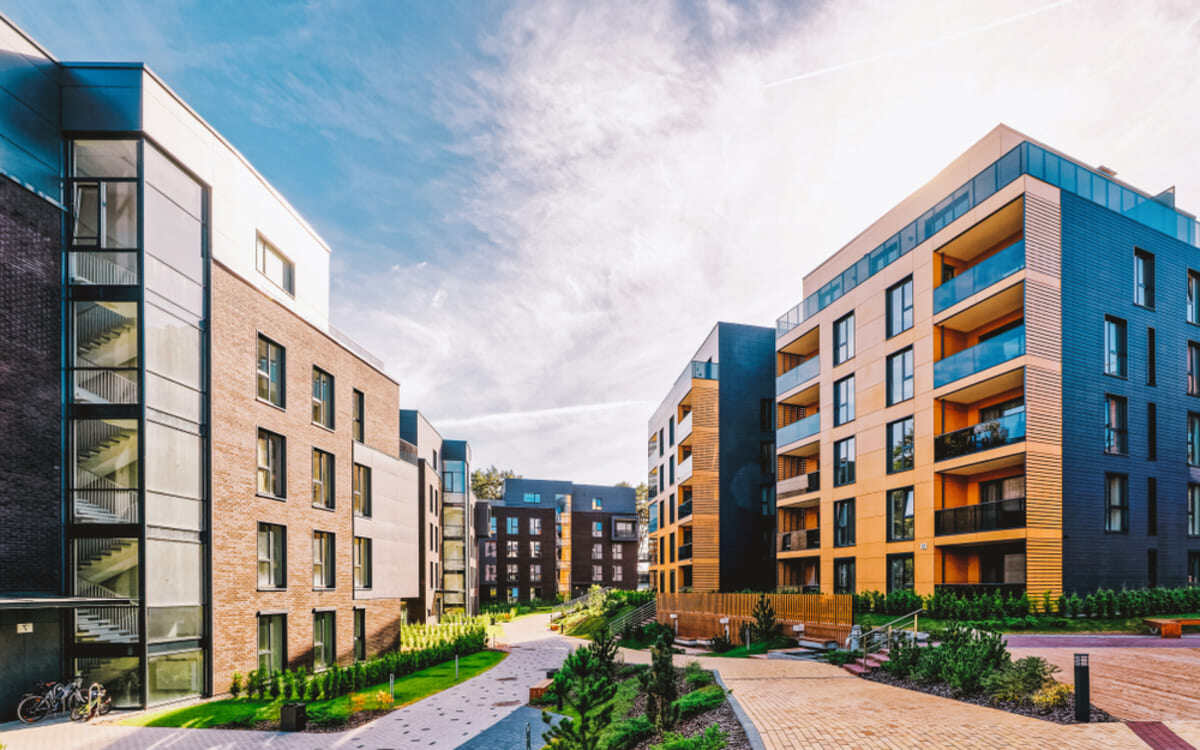Managing multi-family properties requires understanding both the real estate market and the unique dynamics of managing residential communities. This field is more than just the day-to-day operations of property upkeep; it involves creating and maintaining valuable relationships with tenants, understanding and adhering to local and federal housing laws, and strategically managing finances to ensure both profitability for rental property owners and affordability for residents.
This guide will simplify multifamily property management, providing tips and strategies for both experienced and new property managers. We'll explore the key components, challenges, and best practices that define success in managing multifamily dwellings.
What Is Multifamily Property Management?
Multifamily property management involves the oversight and operation of residential properties with multiple housing units, such as apartment buildings, duplexes, or condominium complexes.
This type of property management involves handling the day-to-day operations, maintenance, leasing, and financial performance of the property. Unlike managing a single-family rental, multifamily management often requires coordination across multiple tenants, units, and shared amenities.
The primary goals of multifamily property management are to:
- Provide a high-quality living experience for residents by ensuring units are well-maintained, issues are addressed promptly, and communal areas are clean and safe.
- Maximize the property’s return on investment for owners by reducing vacancies, setting competitive rental rates, collecting rent efficiently, and keeping operational costs under control.
Successful multifamily management balances tenant satisfaction with operational efficiency to create a thriving, profitable community for both residents and property owners.
Types of Multi-Family Properties
Multifamily properties come in various sizes and styles, including:
- Duplexes
- Apartment Complexes
- Condominiums
Each presents unique management challenges and opportunities. In this section, we'll explore three common types of multi-family properties.
Duplexes
Duplexes are a unique type of multi-family property. They consist of two distinct living spaces within a single building structure. Each unit typically has its own entrance, and the units can be side-by-side or stacked on top of one another.
For property managers, duplexes represent a manageable entry into the multi-family market. This is because of their smaller size and because they house fewer tenants than larger apartment complexes. However, its important to balance the needs and privacy of the households while ensuring the property remains profitable.
Property managers must be adept at managing duplexes' individual tenant relations, often mediating between households or addressing issues that affect both units. Additionally, duplex marketing and leasing strategies can differ from those of apartments. Duplexes appeal to those looking for a more house-like living experience with fewer neighbors. Effective management involves:
- An understanding of the local rental market.
- Proactive approach to maintenance.
- Upgrades to keep both units appealing and functional.
Apartment Complexes
Apartment complexes are larger multi-family properties with multiple rental units housed within one or more buildings. These properties range from small buildings with a few units to massive complexes with hundreds of apartments.
For property managers, managing apartment complexes is a substantial step up in complexity and responsibility compared to managing duplexes. You need a robust system for handling a wide array of tasks. This includes but is not limited to tenant management, facility maintenance, lease administration, and financial oversight.
Effective communication and organizational skills are critical to successful apartment complex management. Property managers must ensure clear communication channels with tenants, staff, and service providers. This involves promptly addressing tenant complaints, coordinating maintenance work, ensuring the safety and security of the property, and more.
Condominiums
Condominiums, often called condos, present a unique challenge for multi-family property managers. Unlike apartment complexes, condos are individually owned units within a larger building or complex.
Property managers must understand community association management and the ability to communicate effectively with a diverse group of stakeholders to manage condominiums. Key responsibilities include enforcing community rules, managing shared amenities, coordinating maintenance and repair work for common areas, and handling the association's finances.
Key Responsibilities of a Multi-Family Property Manager
The role of the multi-family property manager is multifaceted. They are responsible for both the business side of property ownership and the welfare of the tenants. Key responsibilities include:
Tenant Relations
This process encompasses many responsibilities, including diligently sourcing and retaining reliable tenants, promptly addressing their complaints, and ensuring a peaceful living environment. It involves:
- Careful tenant screening to find individuals who will respect the property and their neighbors
- Regular maintenance to keep the property in top condition
- Effective communication skills to handle any issues that arise
This creates a harmonious living situation for everyone involved.
Accounting and Financial Management
Managing an annual budget, collecting rent, and keeping track of expenses is just the tip of the financial iceberg. Property managers must also ensure that the property meets all financial obligations, such as taxes and insurance.
 Maintenance and Upkeep
Maintenance and Upkeep
It is critical to maintain the property to a high standard. This retains its value and provides tenants with a safe and comfortable living environment.
An important aspect of property maintenance is managing costs and developing a maintenance budget. However, how do you know what is considered reasonable or necessary for a maintenance budget?
The 50%, 1%, and square footage rules can help you plan your maintenance costs effectively.
- The 50% Rule: Set aside 50% of your monthly rental income for property maintenance and repairs.
- The 1% Rule: Allocate about 1% of the property's value annually for maintenance and repairs.
- The Square Footage Rule: Reserve $1 per square foot annually for unexpected property repairs and other maintenance expenses.
You can adjust these numbers as you learn more about the property's earnings and maintenance needs. However, this is a good starting point for any property manager beginning to plan a budget.
Marketing and Leasing
When vacancies occur, property managers face the critical task of marketing the units to attract the right tenants. This involves:
- Deploying a strategic marketing plan that highlights the unique features and benefits of the property
- Utilizing various advertising platforms to reach potential tenants
- Conducting thorough screenings to ensure a good tenant match
Doing this as quickly as possible minimizes vacancy periods and maintains steady rental income.
Common Multi-Family Management Challenges
Despite multifamily real estate's professional and personal rewards, it still has its share of challenges. Here are some you might face:
Higher Turnover
The first major issue is higher turnover rates. Tenants living in single-family properties are more likely to stay longer than tenants in multi-family properties. Although this is true, there is less risk involved in tenant turnover for multi-family properties because other residents pay the rent.
Managing Utilities
Managing maintenance and utilities can be more difficult for multi-family properties as there are more units to oversee. Each unit has separate utilities that need to be paid for and maintained. Planning your maintenance budget and creating a plan for regular maintenance can help regulate the challenges of this cost and keep utilities running smoothly for tenants.
More Tenants = More Responsibilities
Like multi-family property utilities that need extra attention, there is also the challenge of managing more tenants. Depending on the property size, you could manage up to 200 tenants at a time. If you don't allocate proper attention to the residents and handle their issues efficiently, you could end up with unhappy tenants or vacancies.
An excellent way to prevent these issues is to have a property management system in place. Property management software will allow tenants to send maintenance requests easily and trigger a task list for the property manager to handle the issue.
Create an efficient system that works for both you and your team. It is important to delegate tasks to responsible representatives and have a dependable maintenance team on standby.
 Elevate Your Multi-Family Property Management Game with Real-Time Consulting Services
Elevate Your Multi-Family Property Management Game with Real-Time Consulting Services
Multi-family property management is a demanding yet rewarding field. By understanding the complexity of the role and being prepared to face the challenges, property managers can ensure that their properties not only survive but thrive.
At Real-Time Consulting Services, we specialize in tailored property management consulting solutions designed to optimize operational efficiency and maximize profitability for multi-family property managers. Our team of seasoned experts brings a wealth of knowledge and hands-on experience in dealing with the unique challenges faced by multi-family properties. From duplexes and apartment complexes to condominiums, our consultancy services encompass a broad spectrum of needs - including tenant relations, financial management, maintenance planning, and strategic marketing and leasing.
By partnering with Real-Time Consulting Services, you can access a dedicated team committed to elevating your property management capabilities. To learn more about multi-family consulting, download our free guide, The Ultimate Guide to Multi-Family Property Management Consulting.

 Maintenance and Upkeep
Maintenance and Upkeep Elevate Your Multi-Family Property Management Game with Real-Time Consulting Services
Elevate Your Multi-Family Property Management Game with Real-Time Consulting Services



